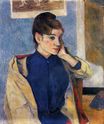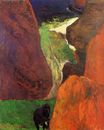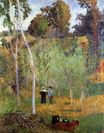Paul Gauguin - Seascape with cow on the edge of a cliff 1888
 |
 |
 |
 |
 |
 |
 |

Seascape with cow on the edge of a cliff 1888
73x60cm oil/canvas
Musée de Arts Decoratifs, Paris, France
The image is only being used for informational and educational purposes
<< Previous G a l l e r y Next >>
From National Gallery of Australia, Canberra:
When Gauguin returned to Brittany in February 1888, it was for most of the year, until autumn, when he left on an ill-fated trip to Arles to join van Gogh. In Brittany he stayed at the Pension Gloanec in the small fishing village of Pont-Aven. During late summer or early autumn (August or September 1888) the artist made a trip to the cliffs overlooking the little Porsac’h creek, sited three kilometres west of Le Pouldu. In a letter to his friend Emile Schuffenecker, written in September 1888, Gauguin philosophised on aesthetic matters:
In the absence of religious painting, what beautiful thoughts can be evoked with form and colour. How prosaic they are, those naturalist painters, with their trompe-l’oeil rendering of nature. We alone sail on our phantom vessels, with all our fanciful imperfection.
Seascape with cow was made around the time that Gauguin gave Sérusier his lesson in intensifying pure colour, which resulted in Sérusier’s The talisman. Gauguin’s dramatic composition is strengthened by arbitrary colouring and his application of bright complementary colours, orange and green. As we look down the cliff, the creek rushes to meet the dark sea, with white surf crashing against the rocks. We catch a glimpse of a red-sailed Breton fishing boat. On land, a black-and-white cow almost leaves the painting. The animal stands near the brightest of haystacks, which are opposed by similar shapes of brown rocks on the left, echoed at the right. The central path of light green water meets a viridian meadow across the front left.